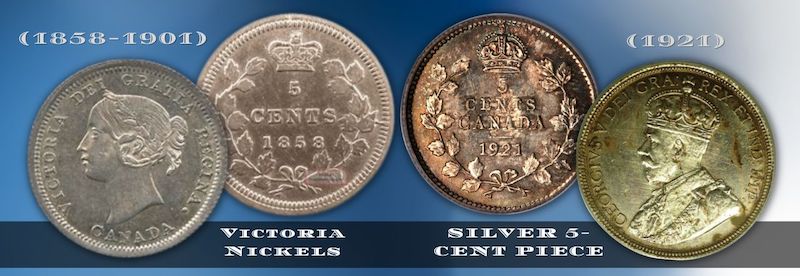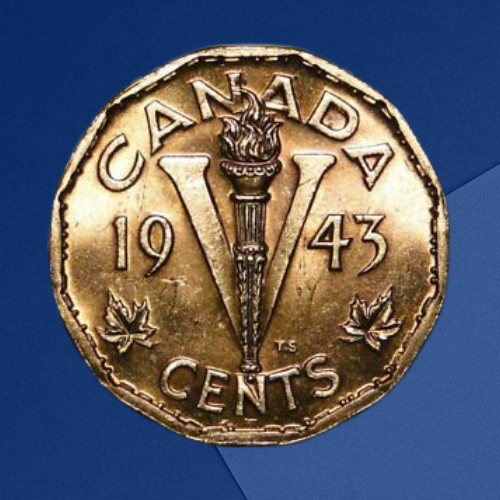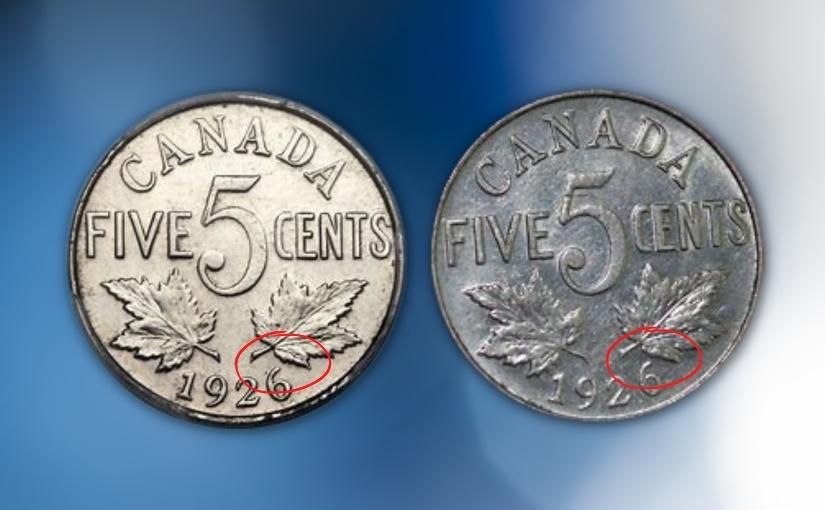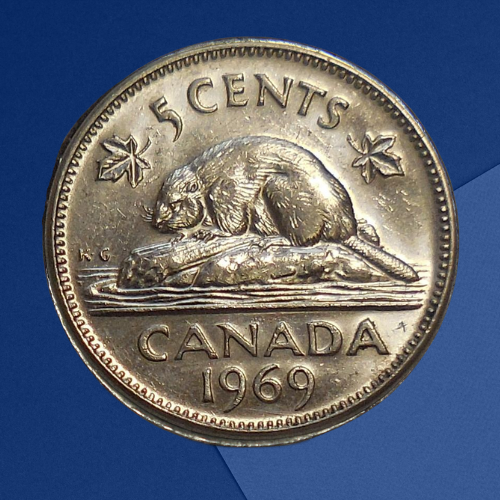Last updated on May 2nd, 2024 at 03:33 pm
Last Updated on May 2, 2024 Posted by Colonial Acres Coins
The nickel was introduced in Canada in 1858, but it wasn’t called a nickel until 1922, when the Royal Canadian Mint actually used nickel to make the coins. A few years later, 1937 saw the introduction of the familiar beaver design. The abdication of Edward VIII caused issues with some coins, but the nickel wasn’t affected. Nickels minted prior to 1936 were more durable than other coins, so there was no need to mint more until after George VI ascended the throne. These rare Canadian nickels can be valuable when found in good condition. Click here to learn more about some Canadian Nickels that are worth money.
From 1939 to 1945, during the Second World War, nickel was valuable to the war effort, so 5-cent coins were made of an alloy of copper and zinc called tombac. These nickels turned brown, which made them appear like pennies, so the nickel was reshaped to a 12-sided coin to differentiate it. Later in the war, nickels were made of chrome-plated steel after the demand for copper and zinc increased.
After the War, the nickel went through several changes and different mints. Except in 1951-1954, the coins were again made of nickel. 1953 marked the ascension of Queen Elizabeth II, and coins began to feature her portrait. In 1963, the coin went back to a round shape. Almost 20 years later, nickel started costing more. The coin’s composition changed to an alloy of copper and nickel. Queen Elizabeth II got an updated portrait in 1990 and again in 2003. It’s been suggested that the government should eliminate the nickel, but this idea died in the House of Commons.
What did the first 5-cent coin in Canada look like?
The first 5-cent coin produced in 1858 was made of silver. Because the coin couldn’t cost more than 5 cents worth of silver, it was quite small, about half the size of the silver 10-cent coin. The diameter of the 5-cent coin was 15.5 mm. In 1922, when Canada went to a 5-cent coin made of nickel, the reverse featured two maple leaves with the words “five cents” and the number 5 featured prominently on the coin. Insert image here 1858 5 Cent
If you are looking for Canadian coins for sale to start or add to a collection, it is good to know which are especially rare and possibly worth more money. Continue reading to learn what Canadian nickels are worth money today. We take a look at five special coins that have unique features or errors that make them popular collector items.

1. VICTORIA NICKELS (1858-1901)
The earliest Canadian five-cent pieces were made out of sterling silver, containing a small amount of copper, rather than nickel. Because of
their size, which was smaller than a dime, these early silver coins were known colloquially as “fish scales.” Then, as now, all Canadian currency bore the effigy of the reigning monarch on the obverse, which was Queen Victoria at the time. It is unusual to find these coins in uncirculated and well-preserved conditions. Coins from certain years, like 1884, are rarer still.
2. SILVER 5-CENT PIECE (1921)
In 1921, the transition from silver to nickel for the Canadian 5-cent coin had already begun. In compliance with the Currency Act of 1921, most of the silver 5-cent coins struck that year were melted down. A few remained intact to sell to visitors to the Mint as souvenirs. An estimated 10 of these coins still exist. As Canada was the world’s biggest nickel producer, it only made sense that the 5-cent coin would be made of nickel. The U.S. had already been calling their 5-cent piece a nickel since the 1860s.
The silver 5-cent pieces are worth thousands of dollars because so many were melted down with the release of the new coin. It’s difficult to find any of these coins in circulation, but who knows what can be found in grandma’s attic? Coin collecting has been a hobby for generations. It’s possible some of your family members collected coins and stored them away because no one seemed interested.
3. TOMBAC VICTORY NICKEL (1944)
 During World War II, nickel was needed for the war effort, so Canadian five-cent pieces were temporarily made of alloys of other metals. In an attempt to increase morale on the homefront, the design on the reverse of the nickel was changed to the “V for Victory” design from 1943 to 1946. In 1943, the five-cent coins were made of tombac, an alloy of zinc and copper. However, these became important to the war effort as well. Starting in 1944, the material was changed to stainless steel.
During World War II, nickel was needed for the war effort, so Canadian five-cent pieces were temporarily made of alloys of other metals. In an attempt to increase morale on the homefront, the design on the reverse of the nickel was changed to the “V for Victory” design from 1943 to 1946. In 1943, the five-cent coins were made of tombac, an alloy of zinc and copper. However, these became important to the war effort as well. Starting in 1944, the material was changed to stainless steel.
However, there is one known 1944 Canadian Victory Nickel made of tombac. According to one theory, it was struck in tombac by accident and may be unique. Another theory holds that the RCM produced 8,000 five-cent coins on tombac planchets but melted most of them down upon deciding on steel with nickel plating for the materials of the five-cent piece.
4. “FAR 6”NICKEL (1926)
 There are two versions of the 1926 Canadian nickel. They are virtually indistinguishable from each other except for one notable difference. The design on the reverse features the name of the country, the denomination of the coin, two decorative maple leaves, and the date of minting at the bottom. The more common variety is the “near 6” nickel, in which the last digit of the date is practically touching the maple leaf above it. 1926 “Near 6” nickels are relatively rare and may be worth a few hundred dollars to a few thousand if in good condition. However, “far 6” nickels, in which the space between the digit and the maple leaf is greater, are rarer. They can sell for as much as $10,000 if in good condition.
There are two versions of the 1926 Canadian nickel. They are virtually indistinguishable from each other except for one notable difference. The design on the reverse features the name of the country, the denomination of the coin, two decorative maple leaves, and the date of minting at the bottom. The more common variety is the “near 6” nickel, in which the last digit of the date is practically touching the maple leaf above it. 1926 “Near 6” nickels are relatively rare and may be worth a few hundred dollars to a few thousand if in good condition. However, “far 6” nickels, in which the space between the digit and the maple leaf is greater, are rarer. They can sell for as much as $10,000 if in good condition.
5. LARGE BEADS NICKEL (1965)
 In 1965, the RCM introduced the new “tiara” effigy, in which the Queen appeared more mature, for the obverse of the coin. This replaced the earlier, more youthful-looking “laureate” design. Two versions of the nickel were struck, the difference being the round beads along the outer rim. One version has 119 small beads around the rim, while the other features 138 large beads. The large-bead coin is rarer and more valuable. In good condition, it can fetch several thousan
In 1965, the RCM introduced the new “tiara” effigy, in which the Queen appeared more mature, for the obverse of the coin. This replaced the earlier, more youthful-looking “laureate” design. Two versions of the nickel were struck, the difference being the round beads along the outer rim. One version has 119 small beads around the rim, while the other features 138 large beads. The large-bead coin is rarer and more valuable. In good condition, it can fetch several thousan
ds of dollars at auction.
VALUABLE NICKELS AND OTHER CANADIAN COINS FOR SALE AT COLONIAL ACRES
If you’re asking the question, “Are Canadian nickels worth anything?” the answer is complicated. It depends on the year of minting, design features, and any errors that occurred during minting. This is where our staff at Colonial Acres can help. We will gladly take the time to look at your valuables with you. There are many resources available to learn more about coins and their values. Reference books and catalogues are available for purchase and not only help with values but share more about the coins’ history and other coins you may want to add to your collection.
Don’t take the Canadian nickels in your possession for granted. If you’ve inherited a coin collection from an older relative, there may be some interesting and rare finds in the collection. When looking to buy Canadian nickels or their silver predecessors, look no further than Colonial Acres Coins. Our Canadian 5-cent coins are categorized according to their year of mintage. Check out what coins we have in stock to add to your collection.




